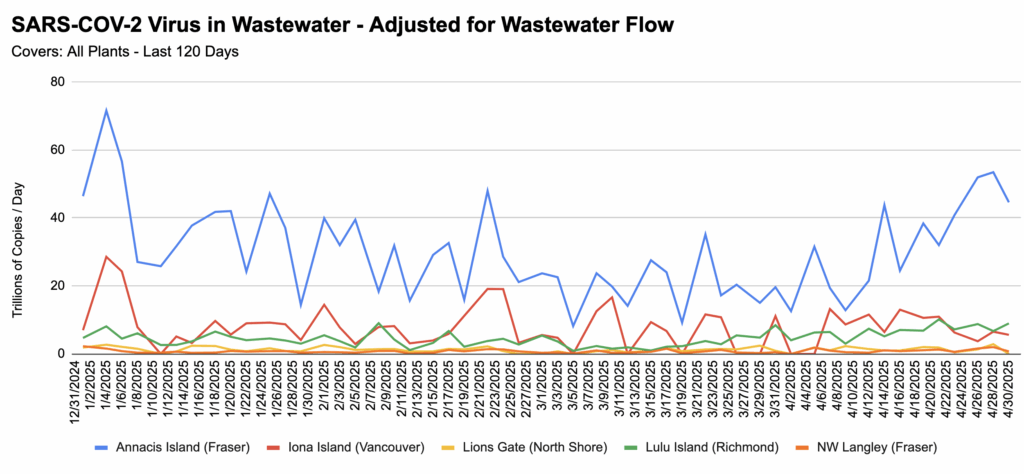COVID-19
Long COVID
👃 This paper from Belgium (2025-05-03) reports that people with COVID-related olfactory disorders had a 17% higher risk of depression and a 22% higher risk of anxiety than asymptomatic people. The severity of the depression or anxiety correlated with the severity of the olfactory disorder and nasal symptoms, and was worse in women than in men.
This paper from USA (2025-05-01) found that 90% of Long COVID patients had lung abnormalities and 57% had heart abnormalities.
🧠 This paper from USA (2025-04-28) reports that Constraint-Induced Cognitive Therapy — progressively challenging computerized brain exercises using BrainHQ — gave significant benefits. (NB: It is not clear to me how much influence BrainHQ’s company had on this study.)
🛌💪 This preprint from Netherlands (2025-05-06) compared skeletal muscles of people with ME/CFS or Long COVID with healthy people on enforced bed rest for sixty days. They found that changes to the skeletal muscles were different between the ME/CFS or Long COVID cohort and the bed rest cohort, showing that weakness and fatigue in the ME/CFS or Long COVID cohort was not simply due to deconditioning.
This review paper (2025-05-07) of eighteen studies of COVID-19 and weight found that being overweight or obese correlated with an increased risk of these Long COVID symptoms:
- +21% persistent depression;
- +23% headache;
- +43% memory issues;
- +31% sleep disturbance;
- +21% vertigo.
People who were obese had increased risks of:
- +45% persistent headache;
- +61% numbness;
- +16% smell disorder;
- +22% taste disorder;
- +44% vertigo.
Note that this does not mean that excess weight makes people more vulnerable: we don’t know the causality or if there are cofactors:
- They did not know the people’s weights before they got COVID-19, so it is possible that Long COVID made them gain weight.
- The overweight and/or obese people might have had underlying conditions which made them more prone to both excess weight and Long COVID.
This paper from Luxembourg (2025-04-25) reports that, based on surveys at several points in time of people who had had COVID-19 infections , there were two different disease trajectories: “mild symptoms, fast resolution and “elevated and persisting symptoms” (i.e. Long COVID). They found that 32.3% of the people who had COVID-19 infections ended up with “elevated and persisting symptoms”.
Various things increased people’s risk of persistent symptoms:
- older age: +86%;
- being female: +81%;
- elevated BMI: +297%;
- multiple comorbidities: +167%.
COVID-Related Excess Death and Sickness
🤧 Okay, this is really strange. From this thread (2025-05-03) come these two heatmaps showing correlation of the number of cases of different infectious diseases over time with each other where red means “perfectly correlated” and blue means “not correlated at all”. The first is pre-COVID:

The second is after non-pharmeceutical intervations against COVID-19 have been dropped:

(I believe the data is from England.)
The person who made these heatmaps points out that a lot of the diseases shown are ones where the disease is really rare unless you have some problem with your immune system. Their point is that COVID-19 messes up your immune system.
Note: This is not peer-reviewed research, it’s some rando on Twitter. (Also note that I am some rando on the Internet.)
This Research Letter from Singapore (2025-04-02) reports on the elevated risk of Type 2 Diabetes (T2D) after Delta- and Omicron-era infections:
- People who had COVID-19 have a 50% higher risk of T2D than historical rates of T2D after influenza;
- People who were unvaccinated or partially vaccinated had a 50% higher risk of T2D;
- People who were hospitalized with COVID-19 had a higher risk of T2D.
NB: The Research Letter did not say what the comparison group for the unvaccinated (#2 above) and hospitalized (#3 above) cohort’s higher risks were. I don’t know if it was vaccinated against unvaccinated for #2 and hospitalized vs. mild cases for #3, or if both groups’ risk was calculated compared to historical rates.
Vaccines
💉 This preprint from Spain (2025-03-07) says that antibody levels waned in vaccinated people, with a half-life of 29 to 60 days to an eventual plateau. The peak response and the plateau depended on the vaccine type, infection status, and how severe the infection was. Another immunization — either from a booster or a breakthrough infection — didn’t change the peak, plateau or decay rate.
This study used data from late 2020 to late 2021, after the first booster campaign finished, so it doesn’t shed any light on what happens with multiple boosters.
💉🎉 This paper (2025-05-07) reports on the Phase 3 results of Moderna’s new COVID-19/influenza combo (mRNA-1083) trial. It compares mRNA-1083 against Spikevax plus the standard flu vax (Fluarix for under-65 y/o or Fluzone for 65+). The new mRNA-1083 stimulated higher immune responses (in blood) than the pair of old vaccines did, against all strains tested except Spikevax+Fluzone did better against B/Yamagata. (They didn’t mention that B/Yamagata is probably extinct).
The paper did report that there were more and more severe side effects from the new vax than from the old vaxes, but that the side effects were still pretty mild.
💉🎉 This paper (2025-04-29) reports that Pfizer’s KP.2 vax was useful. Compared to not getting a booster between September 5 and November 30, 2024, Pfizer’s KP.2 vax had effectiveness in adult military veterans of:
| Against | VE |
| hospitalizations | 68% |
| emergency department / urgent care visits | 57% |
| outpatient visits | 56% |
Reminder: the comparison (no-booster) cohort probably had a fair number of people in it who had had recent COVID-19 infections, so the number is a lower than it would be if the comparison cohort had never gotten infected before.
🩸📆 This paper (2025-04-29) reports that an influenza vaccination — alone or with a COVID-19 vaccination — can lengthen women’s menstrual cycle.
These changes happened when they were vaccinated in the follicular phase (end of bleeding up to ovulation) but never happened in the luteal phase (post-ovulation, pre-bleeding). The length of the menstrual cycle was extended by about a half a day on average:
- extended by 0.40 days for influenza-only vaccination;
- extended by 0.49 days for influenza and COVID-19 at the same time;
- 4.7% had a change of at least eight days with influenza-only vaccination;
- 5.9% had a change of at least 42 days (😭‼️) with influenza and COVID-19 vaccinations together.
All the women returned to normal in their next menstrual cycle.
❤️🩹 This paper from Sweden (2025-05-08) linked three gene variants were linked to myocarditis or pericarditis after vaccination.
Transmission
This paper from USA (2025-04-11) reports that people with high levels of chemical intolerance had an 3.3 times higher risk of getting COVID-19 than the low-intolerance group.
Treatments
💊 This paper from Spain (2025-04-21) found that delaying antivirals to patients was bad. Longer delays in getting the antivirals to the patient meant a +18% per day-of-delay increased risk of “worse outcome” (<- not defined in the abstract). Prescription by an emergency department doctor was associated with a reduction of 6.8 hrs in total time-to-treatment and a 8.5 hour reduction in time-from-hospital-admission to giving-an-antiviral.
Testing
This paper from China (2025-05-02) reports that the authors have developed a really really cheap DNA/RNA detector that is really really fast (USD ten cents!) and really really sensitive. WANT!
The test works by using a chemical which changes how tightly it binds to a test tube when it encounters the target RNA/DNA. Thus to see the results of the test, you just invert the test tube: if liquid falls out when you tip it over, you’re negative, and if no liquid falls out, you’re positive. (Or vice versa, they can make the test work either way.)
Unexpected Consequences
🔥 This paper from USA (2025-04-08) points out that the 2020 fire season in the USA was really bad, not just because of dry conditions, but also because of a steep rise in human-started fires: 20% more in 2020 than the 1992–2019 average. The authors theorize that this was due to more people seeking recreation outdoors because of distancing mitigation measures. The paper points out that the number of recreation-caused wildfires during summer was 36% greater than the 1992–2019 average.
I do not have information on how many human-caused — and specifically recreation-caused — fires there were in 2021/2022/2023/2024.
Recommended Reading
This transcript of an interview from USA (2025-05-04 paywalled; archive version) about the rise of fascism/anti-science, eugenics/etc. to COVID-19. Example:
supremacist ideas…accelerated during Covid. For people who wanted an argument about why they didn’t need to do anything — whether it was mask, or get vaccinated, or close their yoga studio, or whatever it was. People started playing with: “Well, what would it feel like to just not give a shit if people die?” And once you play with that, you’re playing with fire. And it starts spreading. And it becomes, “Well, who else could we say it’s OK if they die?”
BC
The Province of British Columbia is only releasing case data once per month over the summer.) So I’m going to put the BC news here on “off weeks”.
Pathology
This report (2025-02-19) says that life expectancy went down in the first few years of the pandemic. Compared to 2019, the drops in expected years of life were:
| Year | Men | Women |
| 2020 | -1.16 | 0 |
| 2021 | -1.81 | -0.65 |
| 2022 | -1.62 | -0.56 |
COVID-19 was the top contributor to loss of life expectancy for women, but drug overdoses were the top contributor for men.
Wastewater
Wastewater COVID-19 levels are definitely going up in Fraser Health. From Jeff’s wastewater spreadsheet:

Measles
Transmission
Something I didn’t get around to talking about last week was measles. According to the federal measles info page (accessed 2025-05-10), Ontario had 256 new cases in the week ending 26 April, Alberta had 66, Manitoba had 4, and Saskatchewan had 3. 😬
This article (2025-05-07) reports that Manitoba is seeing community spread (i.e. people who didn’t have any contacts with a known case).
H5N1
Transmission
🐄🐦⬛🤧This article (2025-05-07) reports that the national total of infected dairy herds in the US is now to 1,053 herds in 17 states.
Mpox
Media
This study (2025-05-08) of memes about mpox found that 60% of them raised awareness, 40% of them gave misinformation and/or were stigmatizing.
